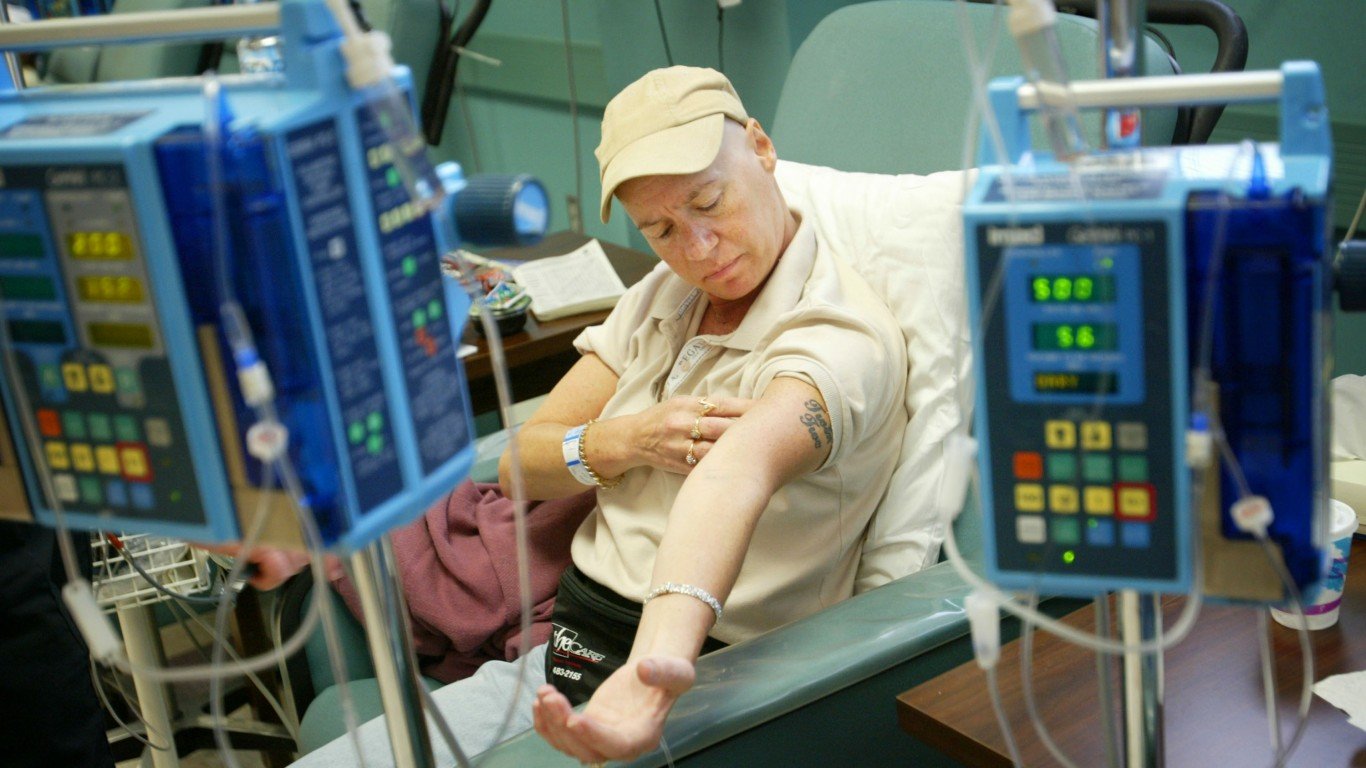

The fear that comes with a cancer diagnosis has roots in the disease’s killer nature. In the United States, where the disease is also the second biggest killer (after heart disease), nearly 600,000 people die from some form of cancer each year, according to the Centers for Disease Control and Prevention.
There is some encouraging news. Cancer death rates declined by 27% in the period between 1991 and 2016, according to the American Cancer Society. This trend is mostly attributed to better early detection and treatment options.
24/7 Tempo reviewed the age-adjusted cancer incidence rate in every state using data compiled by the Centers for Disease Control and Prevention to identify the incidence of cancer in every state.
Though fewer people are dying from cancer, diagnoses of the disease are expected to increase to more than 1 million in men and more than 900,000 in women by the end of 2020. That’s 24% and 21% higher than the total of new cancer cases detected in 2010, respectfully.
One reason for the increased diagnoses is the fact that people live longer — and age is the biggest risk factor for cancer.
The sooner a cancer is diagnosed the better the odds of beating it. The problem is that many cancers, regardless of their type, often have non-specific symptoms, such as fatigue, that people ignore. Here are 20 common cancer symptoms to catch early.
Nationwide in 2017, the latest year for which data is available, nearly 430 new cancer cases were diagnosed for every 100,000 people. In the U.S., approximately 39 out of 100 men and 38 out of 100 women will develop some form of cancer during their lifetime — these are the most common types of cancer in men and women.
Click here for the states with the highest and lowest cancer rates
Click here for our methodology

50. New Mexico
> Cancer diagnoses in 2017 per 100,000 people: 361 (69 fewer than U.S. avg. of 430 per 100,000 people)
> Total number of cancer diagnoses in 2017: 9,261
> Cancer deaths: 3,620 or 138 per 100,000 people — 7th lowest
> Female breast cancer incidence: 1,470 or 113 per 100,000 women — 6th lowest
> Prostate cancer incidence: 1,081 or 82 per 100,000 men — 2nd lowest
> Lung cancer incidence: 905 or 34 per 100,000 people — 2nd lowest
> Adult smoking rate: 17.5% — 20th highest
> Adult obesity rate: 26.6% — 13th lowest
> Residents without health insurance: 10.0% — 15th highest
[in-text-ad]
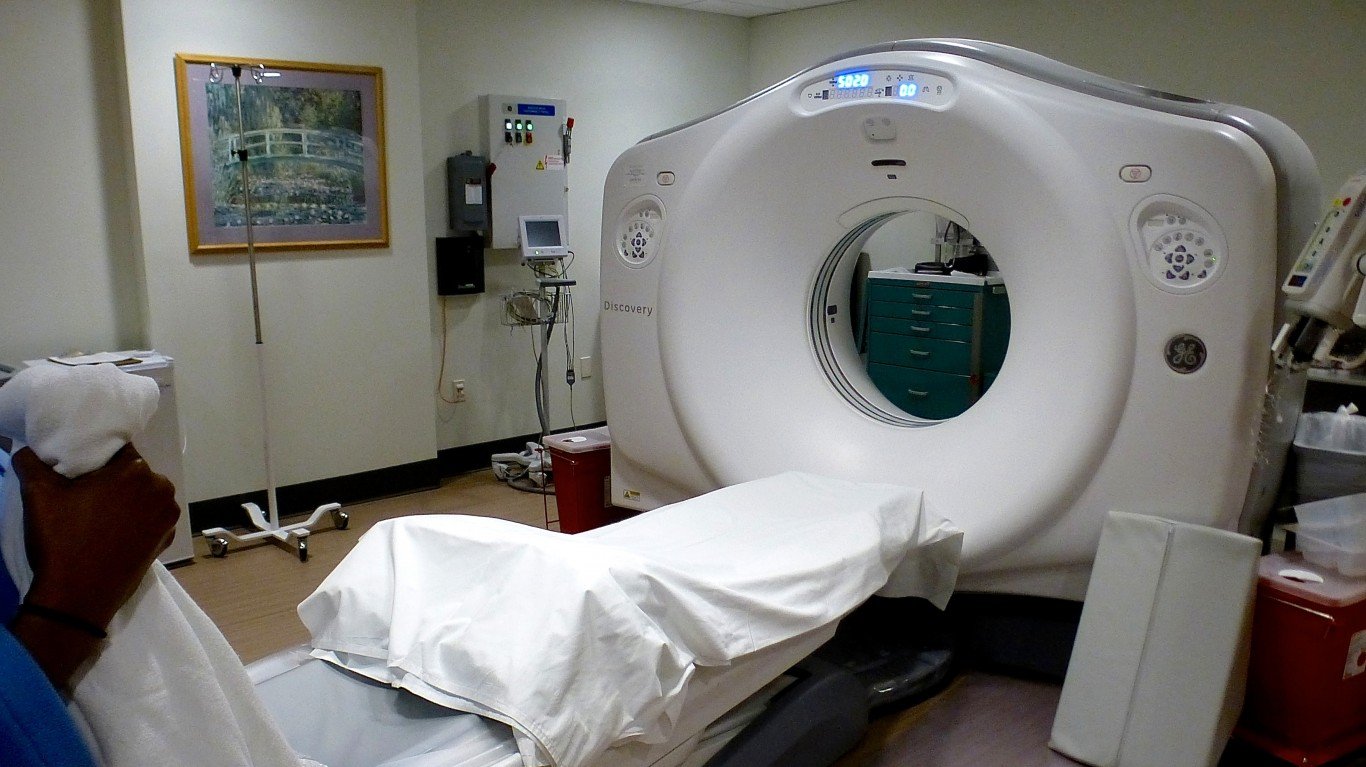
49. Arizona
> Cancer diagnoses in 2017 per 100,000 people: 375 (55 fewer than U.S. avg. of 430 per 100,000 people)
> Total number of cancer diagnoses in 2017: 32,494
> Cancer deaths: 12,008 or 135 per 100,000 people — 4th lowest
> Female breast cancer incidence: 4,754 or 109 per 100,000 women — 2nd lowest
> Prostate cancer incidence: 3,504 or 80 per 100,000 men — the lowest
> Lung cancer incidence: 3,968 or 43 per 100,000 people — 6th lowest
> Adult smoking rate: 15.6% — 16th lowest
> Adult obesity rate: 27.5% — 14th lowest
> Residents without health insurance: 11.3% — 9th highest

48. California
> Cancer diagnoses in 2017 per 100,000 people: 392 (38 fewer than U.S. avg. of 430 per 100,000 people)
> Total number of cancer diagnoses in 2017: 170,784
> Cancer deaths: 59,515 or 137 per 100,000 people — 6th lowest
> Female breast cancer incidence: 27,436 or 121 per 100,000 women — 19th lowest
> Prostate cancer incidence: 20,053 or 94 per 100,000 men — 9th lowest
> Lung cancer incidence: 16,803 or 39 per 100,000 people — 3rd lowest
> Adult smoking rate: 11.3% — 2nd lowest
> Adult obesity rate: 23.6% — 2nd lowest
> Residents without health insurance: 7.7% — 22nd lowest

47. Colorado
> Cancer diagnoses in 2017 per 100,000 people: 394 (36 fewer than U.S. avg. of 430 per 100,000 people)
> Total number of cancer diagnoses in 2017: 24,226
> Cancer deaths: 7,829 or 131 per 100,000 people — 3rd lowest
> Female breast cancer incidence: 4,191 or 132 per 100,000 women — 16th highest
> Prostate cancer incidence: 2,847 or 91 per 100,000 men — 7th lowest
> Lung cancer incidence: 2,418 or 40 per 100,000 people — 5th lowest
> Adult smoking rate: 14.6% — 12th lowest
> Adult obesity rate: 21.8% — the lowest
> Residents without health insurance: 8.0% — 25th highest
[in-text-ad-2]

46. Utah
> Cancer diagnoses in 2017 per 100,000 people: 397 (33 fewer than U.S. avg. of 430 per 100,000 people)
> Total number of cancer diagnoses in 2017: 10,951
> Cancer deaths: 3,160 or 121 per 100,000 people — the lowest
> Female breast cancer incidence: 1,584 or 112 per 100,000 women — 4th lowest
> Prostate cancer incidence: 1,526 or 112 per 100,000 men — 22nd highest
> Lung cancer incidence: 672 or 25 per 100,000 people — the lowest
> Adult smoking rate: 8.9% — the lowest
> Adult obesity rate: 25.9% — 9th lowest
> Residents without health insurance: 9.7% — 17th highest
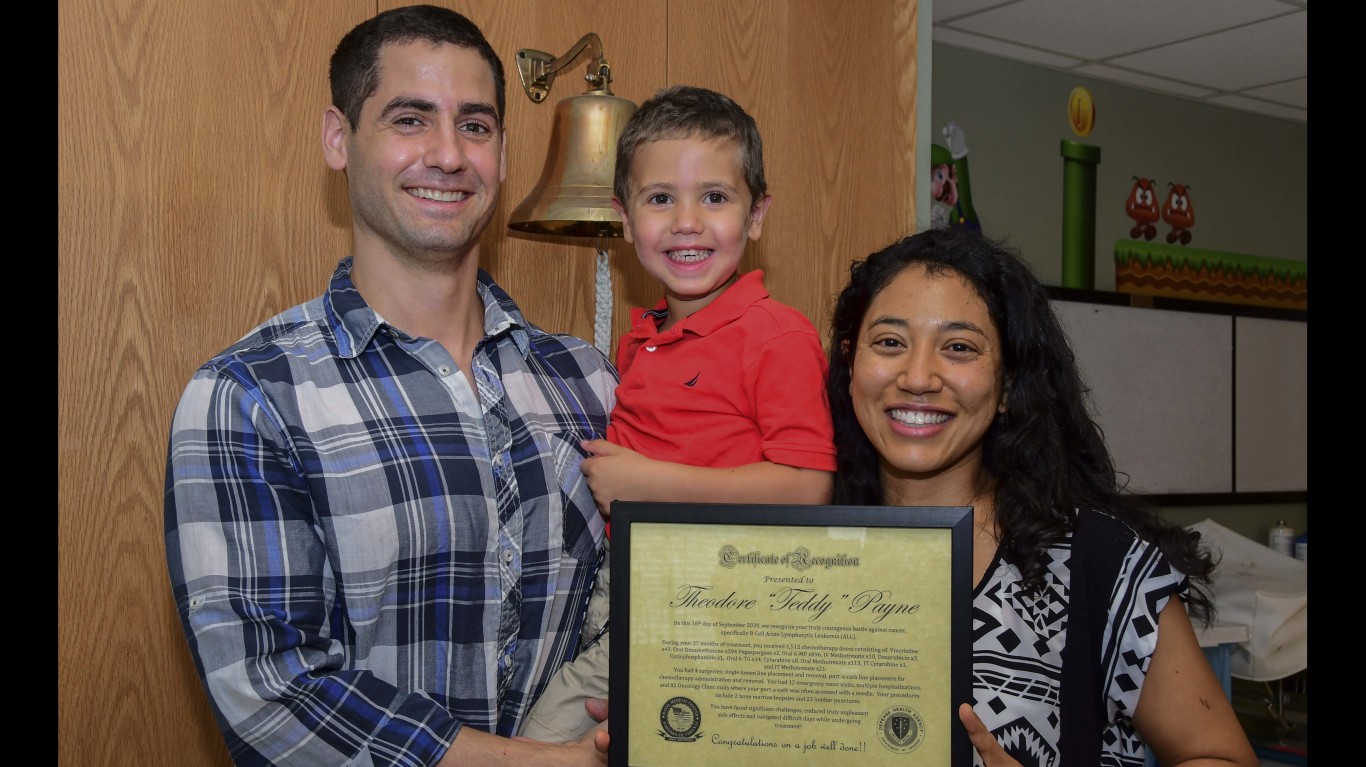
45. Virginia
> Cancer diagnoses in 2017 per 100,000 people: 400 (30 fewer than U.S. avg. of 430 per 100,000 people)
> Total number of cancer diagnoses in 2017: 39,910
> Cancer deaths: 15,064 or 153 per 100,000 people — 20th lowest
> Female breast cancer incidence: 6,327 or 121 per 100,000 women — 18th lowest
> Prostate cancer incidence: 5,022 or 100 per 100,000 men — 18th lowest
> Lung cancer incidence: 5,219 or 51 per 100,000 people — 14th lowest
> Adult smoking rate: 16.4% — 23rd lowest
> Adult obesity rate: 29.8% — 23rd lowest
> Residents without health insurance: 7.9% — 24th lowest
[in-text-ad]

44. Texas
> Cancer diagnoses in 2017 per 100,000 people: 400 (30 fewer than U.S. avg. of 430 per 100,000 people)
> Total number of cancer diagnoses in 2017: 114,402
> Cancer deaths: 40,668 or 147 per 100,000 people — 15th lowest
> Female breast cancer incidence: 16,967 or 113 per 100,000 women — 5th lowest
> Prostate cancer incidence: 13,729 or 99 per 100,000 men — 15th lowest
> Lung cancer incidence: 13,427 or 48 per 100,000 people — 10th lowest
> Adult smoking rate: 15.7% — 18th lowest
> Adult obesity rate: 30.1% — 25th lowest
> Residents without health insurance: 18.4% — the highest

43. Alaska
> Cancer diagnoses in 2017 per 100,000 people: 405 (25 fewer than U.S. avg. of 430 per 100,000 people)
> Total number of cancer diagnoses in 2017: 2,917
> Cancer deaths: 926 or 140 per 100,000 people — 9th lowest
> Female breast cancer incidence: 398 or 111 per 100,000 women — 3rd lowest
> Prostate cancer incidence: 338 or 90 per 100,000 men — 4th lowest
> Lung cancer incidence: 363 or 53 per 100,000 people — 17th lowest
> Adult smoking rate: 21.0% — 9th highest
> Adult obesity rate: 32.5% — 14th highest
> Residents without health insurance: 12.2% — 7th highest
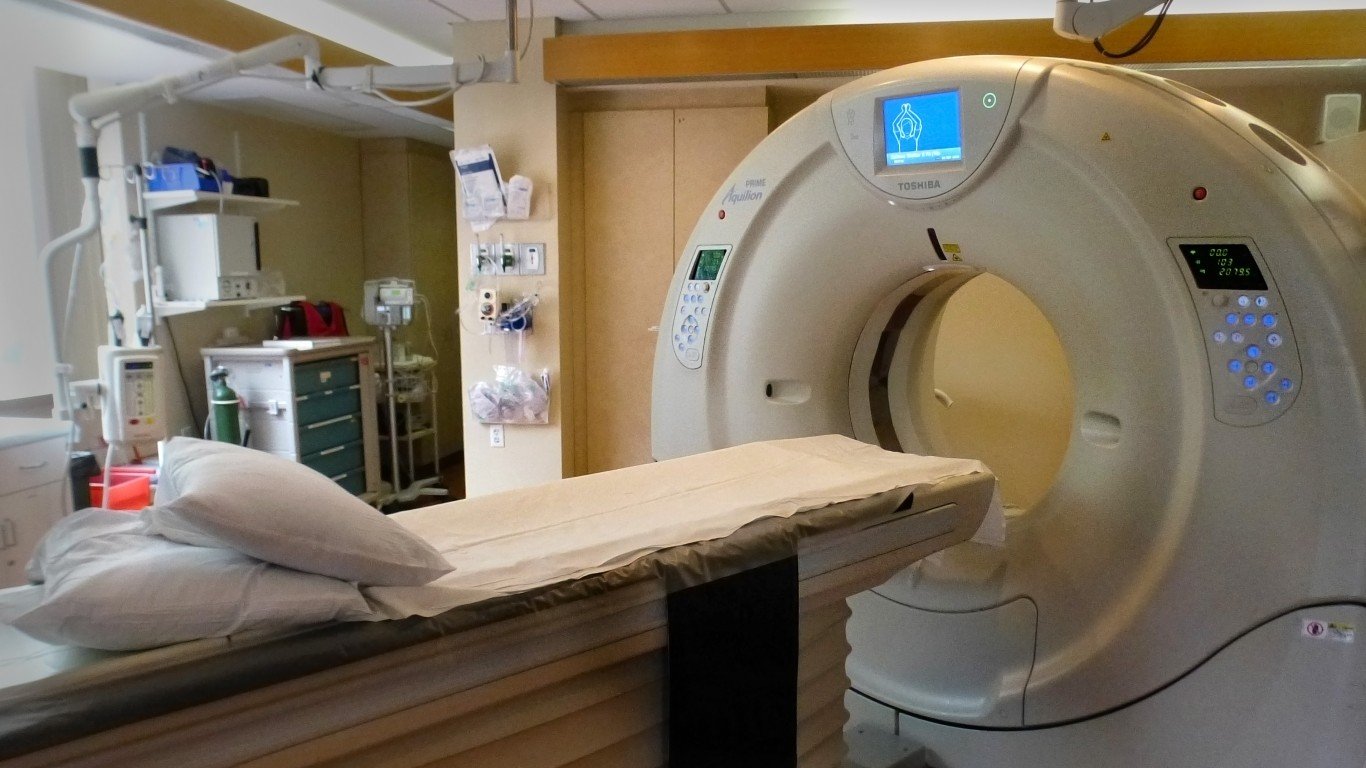
42. Nevada
> Cancer diagnoses in 2017 per 100,000 people: 405 (25 fewer than U.S. avg. of 430 per 100,000 people)
> Total number of cancer diagnoses in 2017: 14,105
> Cancer deaths: 5,283 or 156 per 100,000 people — 23rd highest
> Female breast cancer incidence: 2,089 or 118 per 100,000 women — 11th lowest
> Prostate cancer incidence: 1,739 or 96 per 100,000 men — 12th lowest
> Lung cancer incidence: 1,709 or 49 per 100,000 people — 12th lowest
> Adult smoking rate: 17.6% — 19th highest
> Adult obesity rate: 25.7% — 6th lowest
> Residents without health insurance: 11.4% — 8th highest
[in-text-ad-2]

41. Wyoming
> Cancer diagnoses in 2017 per 100,000 people: 412 (18 fewer than U.S. avg. of 430 per 100,000 people)
> Total number of cancer diagnoses in 2017: 2,875
> Cancer deaths: 948 or 136 per 100,000 people — 5th lowest
> Female breast cancer incidence: 363 or 108 per 100,000 women — the lowest
> Prostate cancer incidence: 489 or 127 per 100,000 men — 9th highest
> Lung cancer incidence: 281 or 40 per 100,000 people — 4th lowest
> Adult smoking rate: 18.7% — 17th highest
> Adult obesity rate: 28.9% — 20th lowest
> Residents without health insurance: 12.3% — 6th highest

40. Oregon
> Cancer diagnoses in 2017 per 100,000 people: 412 (18 fewer than U.S. avg. of 430 per 100,000 people)
> Total number of cancer diagnoses in 2017: 21,528
> Cancer deaths: 8,083 or 154 per 100,000 people — 25th highest
> Female breast cancer incidence: 3,154 or 119 per 100,000 women — 15th lowest
> Prostate cancer incidence: 2,491 or 91 per 100,000 men — 7th lowest
> Lung cancer incidence: 2,640 or 48 per 100,000 people — 11th lowest
> Adult smoking rate: 16.1% — 21st lowest
> Adult obesity rate: 28.8% — 19th lowest
> Residents without health insurance: 7.2% — 20th lowest
[in-text-ad]

39. Hawaii
> Cancer diagnoses in 2017 per 100,000 people: 419 (11 fewer than U.S. avg. of 430 per 100,000 people)
> Total number of cancer diagnoses in 2017: 7,561
> Cancer deaths: 2,456 or 129 per 100,000 people — 2nd lowest
> Female breast cancer incidence: 1,285 or 144 per 100,000 women — the highest
> Prostate cancer incidence: 901 or 99 per 100,000 men — 16th lowest
> Lung cancer incidence: 858 or 45 per 100,000 people — 7th lowest
> Adult smoking rate: 12.8% — 4th lowest
> Adult obesity rate: 23.7% — 3rd lowest
> Residents without health insurance: 4.2% — 3rd lowest
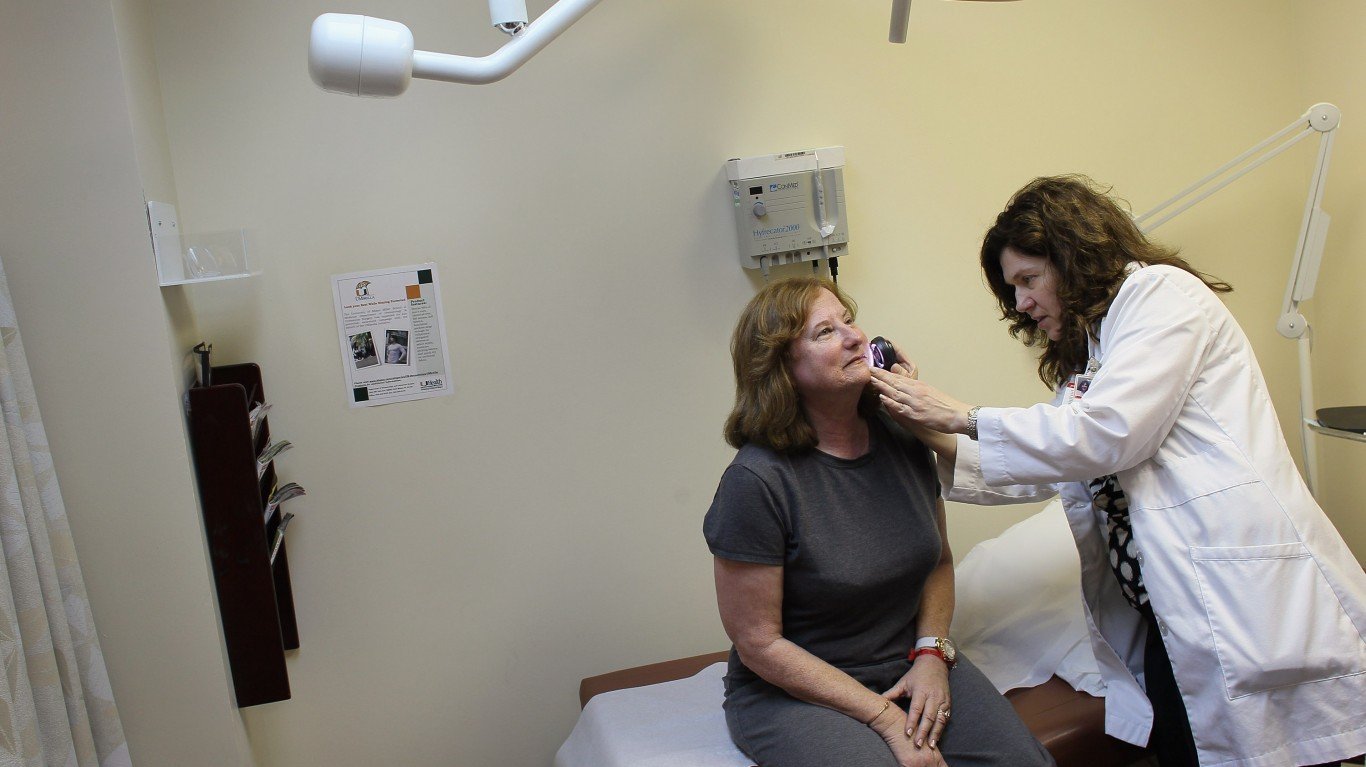
38. Florida
> Cancer diagnoses in 2017 per 100,000 people: 426 (4 fewer than U.S. avg. of 430 per 100,000 people)
> Total number of cancer diagnoses in 2017: 124,804
> Cancer deaths: 45,129 or 145 per 100,000 people — 12th lowest
> Female breast cancer incidence: 16,684 or 114 per 100,000 women — 7th lowest
> Prostate cancer incidence: 12,463 or 84 per 100,000 men — 3rd lowest
> Lung cancer incidence: 17,068 or 54 per 100,000 people — 19th lowest
> Adult smoking rate: 16.1% — 22nd lowest
> Adult obesity rate: 26.6% — 13th lowest
> Residents without health insurance: 13.2% — 4th highest

37. Oklahoma
> Cancer diagnoses in 2017 per 100,000 people: 432 (2 more than U.S. avg. of 430 per 100,000 people)
> Total number of cancer diagnoses in 2017: 19,871
> Cancer deaths: 8,203 or 177 per 100,000 people — 4th highest
> Female breast cancer incidence: 2,953 or 124 per 100,000 women — 20th lowest
> Prostate cancer incidence: 2,097 or 91 per 100,000 men — 8th lowest
> Lung cancer incidence: 2,965 or 62 per 100,000 people — 13th highest
> Adult smoking rate: 20.1% — 12th highest
> Adult obesity rate: 33.7% — 7th highest
> Residents without health insurance: 14.3% — 2nd highest
[in-text-ad-2]

36. Rhode Island
> Cancer diagnoses in 2017 per 100,000 people: 434 (4 more than U.S. avg. of 430 per 100,000 people)
> Total number of cancer diagnoses in 2017: 5,841
> Cancer deaths: 2,154 or 154 per 100,000 people — 25th lowest
> Female breast cancer incidence: 960 or 137 per 100,000 women — 5th highest
> Prostate cancer incidence: 659 or 99 per 100,000 men — 17th lowest
> Lung cancer incidence: 859 or 62 per 100,000 people — 14th highest
> Adult smoking rate: 14.9% — 13th lowest
> Adult obesity rate: 28.1% — 18th lowest
> Residents without health insurance: 4.1% — 2nd lowest

35. South Carolina
> Cancer diagnoses in 2017 per 100,000 people: 434 (5 more than U.S. avg. of 430 per 100,000 people)
> Total number of cancer diagnoses in 2017: 27,762
> Cancer deaths: 10,356 or 163 per 100,000 people — 14th highest
> Female breast cancer incidence: 4,291 or 130 per 100,000 women — 22nd highest
> Prostate cancer incidence: 3,488 or 108 per 100,000 men — 22nd lowest
> Lung cancer incidence: 4,137 or 62 per 100,000 people — 17th highest
> Adult smoking rate: 18.8% — 15th highest
> Adult obesity rate: 32.9% — 12th highest
> Residents without health insurance: 10.8% — 11th highest
[in-text-ad]

34. Indiana
> Cancer diagnoses in 2017 per 100,000 people: 435 (5 more than U.S. avg. of 430 per 100,000 people)
> Total number of cancer diagnoses in 2017: 34,318
> Cancer deaths: 13,462 or 170 per 100,000 people — 9th highest
> Female breast cancer incidence: 4,945 or 120 per 100,000 women — 17th lowest
> Prostate cancer incidence: 3,681 or 95 per 100,000 men — 10th lowest
> Lung cancer incidence: 5,379 or 66 per 100,000 people — 8th highest
> Adult smoking rate: 21.8% — 7th highest
> Adult obesity rate: 33.4% — 8th highest
> Residents without health insurance: 8.7% — 22nd highest

33. Washington
> Cancer diagnoses in 2017 per 100,000 people: 435 (5 more than U.S. avg. of 430 per 100,000 people)
> Total number of cancer diagnoses in 2017: 37,522
> Cancer deaths: 12,664 or 148 per 100,000 people — 16th lowest
> Female breast cancer incidence: 5,897 or 133 per 100,000 women — 15th highest
> Prostate cancer incidence: 4,392 or 99 per 100,000 men — 15th lowest
> Lung cancer incidence: 4,349 or 50 per 100,000 people — 13th lowest
> Adult smoking rate: 13.5% — 5th lowest
> Adult obesity rate: 27.8% — 15th lowest
> Residents without health insurance: 6.6% — 17th lowest

32. Michigan
> Cancer diagnoses in 2017 per 100,000 people: 435 (6 more than U.S. avg. of 430 per 100,000 people)
> Total number of cancer diagnoses in 2017: 54,793
> Cancer deaths: 20,671 or 161 per 100,000 people — 15th highest
> Female breast cancer incidence: 7,582 or 119 per 100,000 women — 15th lowest
> Prostate cancer incidence: 6,823 or 106 per 100,000 men — 21st lowest
> Lung cancer incidence: 7,887 or 60 per 100,000 people — 21st highest
> Adult smoking rate: 19.3% — 13th highest
> Adult obesity rate: 32.0% — 18th highest
> Residents without health insurance: 5.8% — 10th lowest
[in-text-ad-2]

31. Idaho
> Cancer diagnoses in 2017 per 100,000 people: 436 (6 more than U.S. avg. of 430 per 100,000 people)
> Total number of cancer diagnoses in 2017: 8,624
> Cancer deaths: 3,020 or 153 per 100,000 people — 23rd lowest
> Female breast cancer incidence: 1,326 or 136 per 100,000 women — 9th highest
> Prostate cancer incidence: 1,159 or 111 per 100,000 men — 24th highest
> Lung cancer incidence: 961 or 47 per 100,000 people — 8th lowest
> Adult smoking rate: 14.3% — 10th lowest
> Adult obesity rate: 29.3% — 21st lowest
> Residents without health insurance: 10.8% — 11th highest
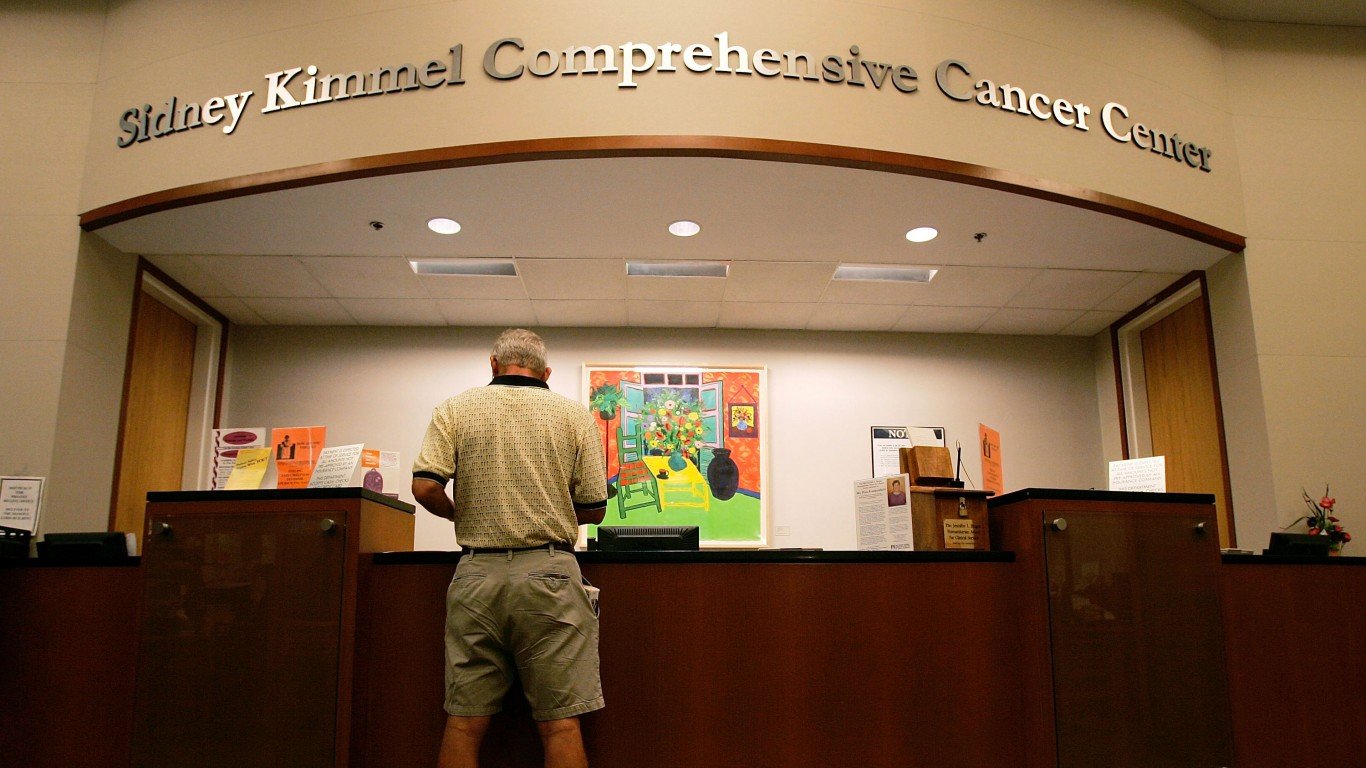
30. Maryland
> Cancer diagnoses in 2017 per 100,000 people: 443 (13 more than U.S. avg. of 430 per 100,000 people)
> Total number of cancer diagnoses in 2017: 31,735
> Cancer deaths: 10,796 or 152 per 100,000 people — 18th lowest
> Female breast cancer incidence: 4,958 or 131 per 100,000 women — 20th highest
> Prostate cancer incidence: 4,402 or 125 per 100,000 men — 10th highest
> Lung cancer incidence: 3,947 or 55 per 100,000 people — 21st lowest
> Adult smoking rate: 13.8% — 8th lowest
> Adult obesity rate: 31.0% — 23rd highest
> Residents without health insurance: 6.0% — 12th lowest
[in-text-ad]

29. Massachusetts
> Cancer diagnoses in 2017 per 100,000 people: 445 (15 more than U.S. avg. of 430 per 100,000 people)
> Total number of cancer diagnoses in 2017: 37,769
> Cancer deaths: 12,934 or 149 per 100,000 people — 17th lowest
> Female breast cancer incidence: 5,966 or 135 per 100,000 women — 10th highest
> Prostate cancer incidence: 4,560 or 108 per 100,000 men — 23rd lowest
> Lung cancer incidence: 5,141 or 59 per 100,000 people — 23rd highest
> Adult smoking rate: 13.7% — 6th lowest
> Adult obesity rate: 24.7% — 4th lowest
> Residents without health insurance: 3.0% — the lowest

28. Delaware
> Cancer diagnoses in 2017 per 100,000 people: 446 (16 more than U.S. avg. of 430 per 100,000 people)
> Total number of cancer diagnoses in 2017: 5,617
> Cancer deaths: 2,085 or 161 per 100,000 people — 16th highest
> Female breast cancer incidence: 765 or 119 per 100,000 women — 16th lowest
> Prostate cancer incidence: 786 or 123 per 100,000 men — 11th highest
> Lung cancer incidence: 761 or 57 per 100,000 people — 25th lowest
> Adult smoking rate: 17.0% — 24th lowest
> Adult obesity rate: 30.9% — 24th highest
> Residents without health insurance: 6.6% — 17th lowest

27. Alabama
> Cancer diagnoses in 2017 per 100,000 people: 447 (17 more than U.S. avg. of 430 per 100,000 people)
> Total number of cancer diagnoses in 2017: 27,137
> Cancer deaths: 10,410 or 170 per 100,000 people — 11th highest
> Female breast cancer incidence: 3,694 or 117 per 100,000 women — 10th lowest
> Prostate cancer incidence: 3,907 or 130 per 100,000 men — 6th highest
> Lung cancer incidence: 3,927 or 62 per 100,000 people — 15th highest
> Adult smoking rate: 20.9% — 10th highest
> Adult obesity rate: 35.5% — 3rd highest
> Residents without health insurance: 9.7% — 17th highest
[in-text-ad-2]

26. Wisconsin
> Cancer diagnoses in 2017 per 100,000 people: 448 (18 more than U.S. avg. of 430 per 100,000 people)
> Total number of cancer diagnoses in 2017: 32,651
> Cancer deaths: 11,318 or 153 per 100,000 people — 24th lowest
> Female breast cancer incidence: 4,858 or 133 per 100,000 women — 14th highest
> Prostate cancer incidence: 4,284 or 113 per 100,000 men — 21st highest
> Lung cancer incidence: 4,234 or 56 per 100,000 people — 23rd lowest
> Adult smoking rate: 16.0% — 20th lowest
> Adult obesity rate: 31.3% — 22nd highest
> Residents without health insurance: 5.7% — 8th lowest

25. South Dakota
> Cancer diagnoses in 2017 per 100,000 people: 450 (20 more than U.S. avg. of 430 per 100,000 people)
> Total number of cancer diagnoses in 2017: 4,739
> Cancer deaths: 1,715 or 157 per 100,000 people — 20th highest
> Female breast cancer incidence: 645 or 125 per 100,000 women — 21st lowest
> Prostate cancer incidence: 649 or 117 per 100,000 men — 18th highest
> Lung cancer incidence: 601 or 56 per 100,000 people — 22nd lowest
> Adult smoking rate: 19.3% — 14th highest
> Adult obesity rate: 31.8% — 20th highest
> Residents without health insurance: 10.2% — 13th highest
[in-text-ad]

24. Kansas
> Cancer diagnoses in 2017 per 100,000 people: 451 (21 more than U.S. avg. of 430 per 100,000 people)
> Total number of cancer diagnoses in 2017: 15,331
> Cancer deaths: 5,493 or 157 per 100,000 people — 22nd highest
> Female breast cancer incidence: 2,289 or 133 per 100,000 women — 12th highest
> Prostate cancer incidence: 2,017 or 117 per 100,000 men — 17th highest
> Lung cancer incidence: 1,855 or 53 per 100,000 people — 16th lowest
> Adult smoking rate: 17.4% — 22nd highest
> Adult obesity rate: 33.2% — 9th highest
> Residents without health insurance: 9.2% — 19th highest
23. Missouri
> Cancer diagnoses in 2017 per 100,000 people: 453 (23 more than U.S. avg. of 430 per 100,000 people)
> Total number of cancer diagnoses in 2017: 34,379
> Cancer deaths: 12,971 or 167 per 100,000 people — 12th highest
> Female breast cancer incidence: 5,124 or 132 per 100,000 women — 18th highest
> Prostate cancer incidence: 3,468 or 90 per 100,000 men — 5th lowest
> Lung cancer incidence: 5,625 or 71 per 100,000 people — 6th highest
> Adult smoking rate: 20.8% — 11th highest
> Adult obesity rate: 32.2% — 16th highest
> Residents without health insurance: 10.0% — 15th highest
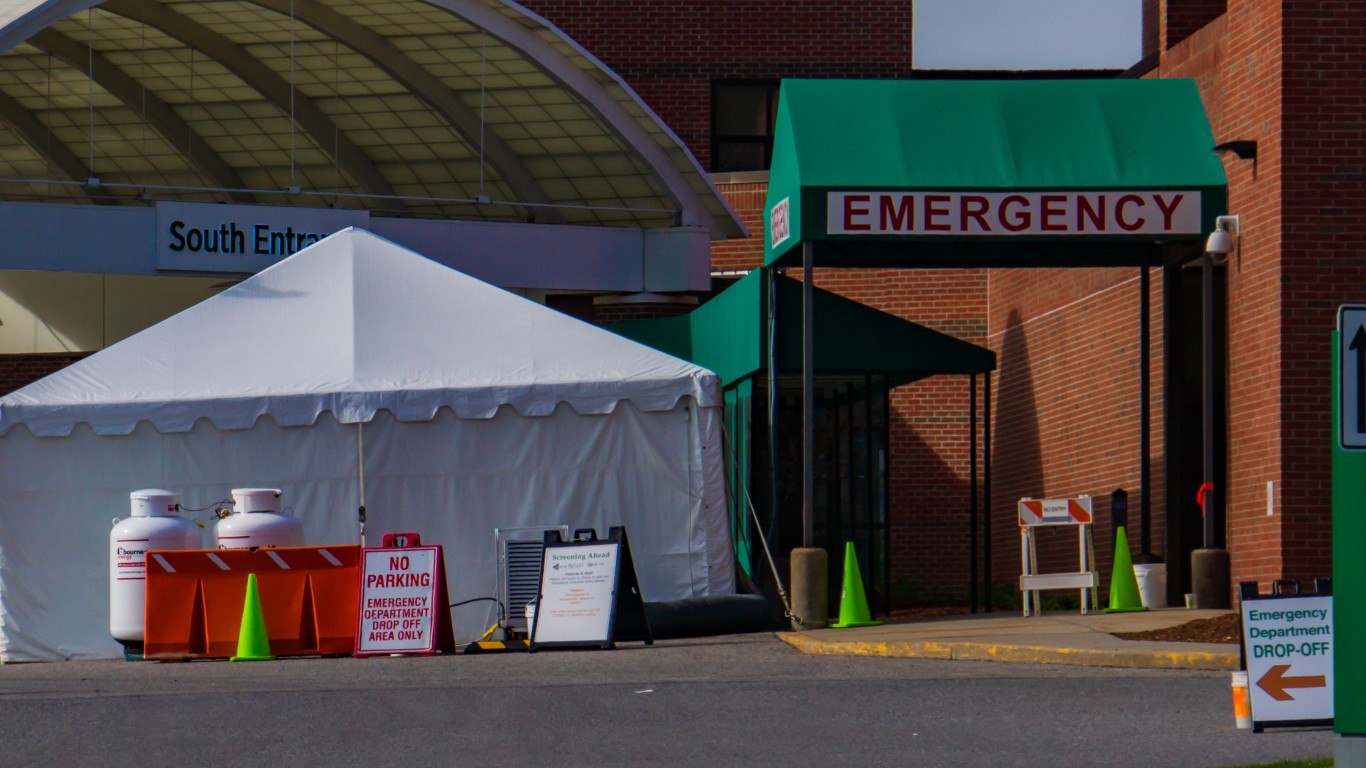
22. Vermont
> Cancer diagnoses in 2017 per 100,000 people: 454 (25 more than U.S. avg. of 430 per 100,000 people)
> Total number of cancer diagnoses in 2017: 3,901
> Cancer deaths: 1,434 or 164 per 100,000 people — 13th highest
> Female breast cancer incidence: 539 or 125 per 100,000 women — 22nd lowest
> Prostate cancer incidence: 463 or 100 per 100,000 men — 19th lowest
> Lung cancer incidence: 506 or 57 per 100,000 people — 24th lowest
> Adult smoking rate: 15.8% — 19th lowest
> Adult obesity rate: 26.3% — 10th lowest
> Residents without health insurance: 4.5% — 4th lowest
[in-text-ad-2]

21. North Dakota
> Cancer diagnoses in 2017 per 100,000 people: 456 (26 more than U.S. avg. of 430 per 100,000 people)
> Total number of cancer diagnoses in 2017: 3,878
> Cancer deaths: 1,280 or 142 per 100,000 people — 11th lowest
> Female breast cancer incidence: 543 or 129 per 100,000 women — 24th highest
> Prostate cancer incidence: 491 or 110 per 100,000 men — 25th highest
> Lung cancer incidence: 522 or 60 per 100,000 people — 20th highest
> Adult smoking rate: 18.3% — 18th highest
> Adult obesity rate: 32.7% — 13th highest
> Residents without health insurance: 6.9% — 19th lowest

20. Tennessee
> Cancer diagnoses in 2017 per 100,000 people: 458 (28 more than U.S. avg. of 430 per 100,000 people)
> Total number of cancer diagnoses in 2017: 37,623
> Cancer deaths: 14,302 or 174 per 100,000 people — 6th highest
> Female breast cancer incidence: 5,095 or 118 per 100,000 women — 12th lowest
> Prostate cancer incidence: 4,874 or 119 per 100,000 men — 16th highest
> Lung cancer incidence: 6,044 or 71 per 100,000 people — 5th highest
> Adult smoking rate: 22.6% — 4th highest
> Adult obesity rate: 33.2% — 9th highest
> Residents without health insurance: 10.1% — 14th highest
[in-text-ad]

19. North Carolina
> Cancer diagnoses in 2017 per 100,000 people: 458 (28 more than U.S. avg. of 430 per 100,000 people)
> Total number of cancer diagnoses in 2017: 57,037
> Cancer deaths: 19,474 or 157 per 100,000 people — 21st highest
> Female breast cancer incidence: 8,738 or 133 per 100,000 women — 12th highest
> Prostate cancer incidence: 7,431 or 121 per 100,000 men — 13th highest
> Lung cancer incidence: 8,093 or 63 per 100,000 people — 11th highest
> Adult smoking rate: 17.2% — 24th highest
> Adult obesity rate: 31.4% — 21st highest
> Residents without health insurance: 11.3% — 9th highest

18. Illinois
> Cancer diagnoses in 2017 per 100,000 people: 459 (29 more than U.S. avg. of 430 per 100,000 people)
> Total number of cancer diagnoses in 2017: 69,222
> Cancer deaths: 24,150 or 158 per 100,000 people — 18th highest
> Female breast cancer incidence: 10,332 or 132 per 100,000 women — 16th highest
> Prostate cancer incidence: 8,313 or 111 per 100,000 men — 23rd highest
> Lung cancer incidence: 9,429 or 61 per 100,000 people — 18th highest
> Adult smoking rate: 15.5% — 15th lowest
> Adult obesity rate: 29.7% — 22nd lowest
> Residents without health insurance: 7.4% — 21st lowest

17. Ohio
> Cancer diagnoses in 2017 per 100,000 people: 459 (29 more than U.S. avg. of 430 per 100,000 people)
> Total number of cancer diagnoses in 2017: 67,268
> Cancer deaths: 25,643 or 171 per 100,000 people — 8th highest
> Female breast cancer incidence: 9,830 or 130 per 100,000 women — 21st highest
> Prostate cancer incidence: 8,155 or 110 per 100,000 men — 25th lowest
> Lung cancer incidence: 9,742 or 64 per 100,000 people — 9th highest
> Adult smoking rate: 21.1% — 8th highest
> Adult obesity rate: 32.3% — 15th highest
> Residents without health insurance: 6.6% — 17th lowest
[in-text-ad-2]

16. Georgia
> Cancer diagnoses in 2017 per 100,000 people: 461 (31 more than U.S. avg. of 430 per 100,000 people)
> Total number of cancer diagnoses in 2017: 52,690
> Cancer deaths: 17,135 or 155 per 100,000 people — 24th highest
> Female breast cancer incidence: 7,757 or 127 per 100,000 women — 24th lowest
> Prostate cancer incidence: 7,337 or 132 per 100,000 men — 4th highest
> Lung cancer incidence: 6,929 or 60 per 100,000 people — 22nd highest
> Adult smoking rate: 17.5% — 21st highest
> Adult obesity rate: 32.0% — 18th highest
> Residents without health insurance: 13.4% — 3rd highest
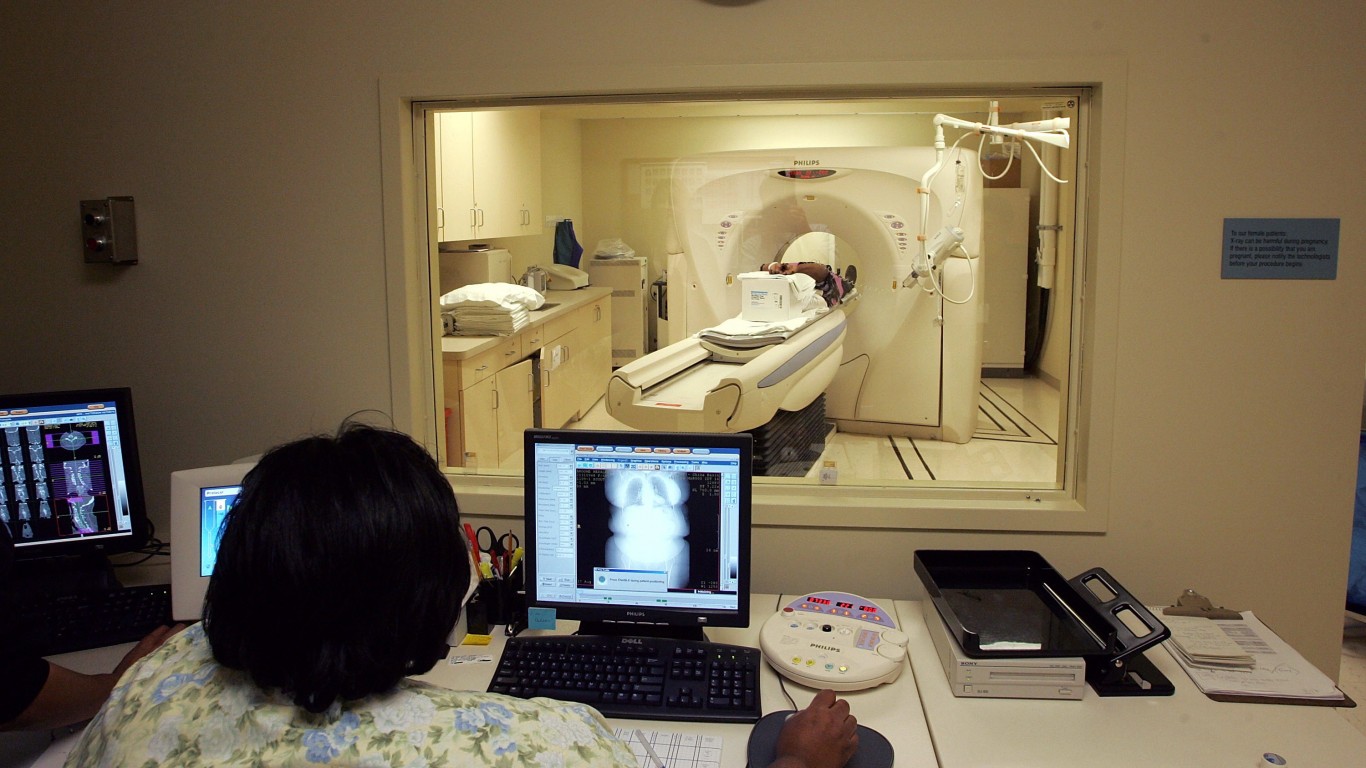
15. Connecticut
> Cancer diagnoses in 2017 per 100,000 people: 465 (35 more than U.S. avg. of 430 per 100,000 people)
> Total number of cancer diagnoses in 2017: 21,297
> Cancer deaths: 6,608 or 140 per 100,000 people — 9th lowest
> Female breast cancer incidence: 3,236 or 137 per 100,000 women — 7th highest
> Prostate cancer incidence: 2,788 or 122 per 100,000 men — 12th highest
> Lung cancer incidence: 2,792 or 59 per 100,000 people — 24th highest
> Adult smoking rate: 12.7% — 3rd lowest
> Adult obesity rate: 25.8% — 8th lowest
> Residents without health insurance: 5.9% — 11th lowest
[in-text-ad]

14. Mississippi
> Cancer diagnoses in 2017 per 100,000 people: 465 (35 more than U.S. avg. of 430 per 100,000 people)
> Total number of cancer diagnoses in 2017: 16,585
> Cancer deaths: 6,526 or 183 per 100,000 people — 2nd highest
> Female breast cancer incidence: 2,204 or 119 per 100,000 women — 13th lowest
> Prostate cancer incidence: 2,259 or 128 per 100,000 men — 7th highest
> Lung cancer incidence: 2,647 or 72 per 100,000 people — 3rd highest
> Adult smoking rate: 22.2% — 6th highest
> Adult obesity rate: 36.8% — the highest
> Residents without health insurance: 13.0% — 5th highest

13. Montana
> Cancer diagnoses in 2017 per 100,000 people: 467 (37 more than U.S. avg. of 430 per 100,000 people)
> Total number of cancer diagnoses in 2017: 6,426
> Cancer deaths: 2,145 or 152 per 100,000 people — 19th lowest
> Female breast cancer incidence: 933 or 138 per 100,000 women — 4th highest
> Prostate cancer incidence: 995 or 131 per 100,000 men — 5th highest
> Lung cancer incidence: 692 or 47 per 100,000 people — 9th lowest
> Adult smoking rate: 17.2% — 25th highest
> Adult obesity rate: 25.8% — 8th lowest
> Residents without health insurance: 8.3% — 23rd highest
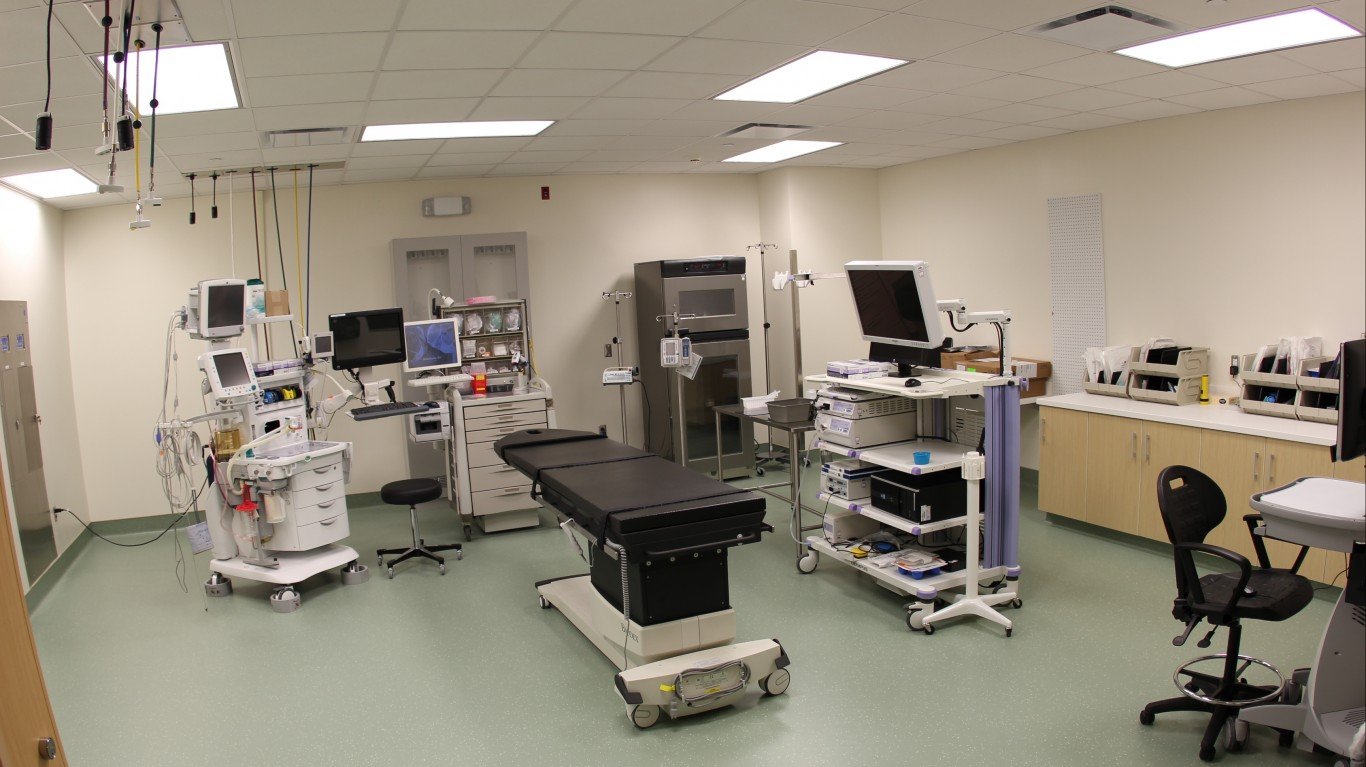
12. Pennsylvania
> Cancer diagnoses in 2017 per 100,000 people: 471 (41 more than U.S. avg. of 430 per 100,000 people)
> Total number of cancer diagnoses in 2017: 79,340
> Cancer deaths: 28,385 or 161 per 100,000 people — 17th highest
> Female breast cancer incidence: 11,213 or 131 per 100,000 women — 19th highest
> Prostate cancer incidence: 8,747 or 102 per 100,000 men — 20th lowest
> Lung cancer incidence: 10,929 or 62 per 100,000 people — 15th highest
> Adult smoking rate: 18.7% — 16th highest
> Adult obesity rate: 30.3% — 25th highest
> Residents without health insurance: 5.8% — 10th lowest
[in-text-ad-2]

11. Nebraska
> Cancer diagnoses in 2017 per 100,000 people: 471 (41 more than U.S. avg. of 430 per 100,000 people)
> Total number of cancer diagnoses in 2017: 10,491
> Cancer deaths: 3,502 or 153 per 100,000 people — 21st lowest
> Female breast cancer incidence: 1,446 or 130 per 100,000 women — 23rd highest
> Prostate cancer incidence: 1,503 or 132 per 100,000 men — 3rd highest
> Lung cancer incidence: 1,256 or 55 per 100,000 people — 21st lowest
> Adult smoking rate: 15.4% — 14th lowest
> Adult obesity rate: 32.2% — 16th highest
> Residents without health insurance: 8.3% — 23rd highest

10. Arkansas
> Cancer diagnoses in 2017 per 100,000 people: 471 (42 more than U.S. avg. of 430 per 100,000 people)
> Total number of cancer diagnoses in 2017: 17,474
> Cancer deaths: 6,516 or 173 per 100,000 people — 7th highest
> Female breast cancer incidence: 2,163 or 115 per 100,000 women — 8th lowest
> Prostate cancer incidence: 2,227 or 120 per 100,000 men — 14th highest
> Lung cancer incidence: 2,777 or 71 per 100,000 people — 4th highest
> Adult smoking rate: 22.3% — 5th highest
> Adult obesity rate: 34.2% — 5th highest
> Residents without health insurance: 9.1% — 20th highest
[in-text-ad]

9. Maine
> Cancer diagnoses in 2017 per 100,000 people: 472 (42 more than U.S. avg. of 430 per 100,000 people)
> Total number of cancer diagnoses in 2017: 9,061
> Cancer deaths: 3,391 or 170 per 100,000 people — 10th highest
> Female breast cancer incidence: 1,256 or 128 per 100,000 women — 25th lowest
> Prostate cancer incidence: 981 or 97 per 100,000 men — 13th lowest
> Lung cancer incidence: 1,392 or 68 per 100,000 people — 7th highest
> Adult smoking rate: 17.3% — 23rd highest
> Adult obesity rate: 29.9% — 24th lowest
> Residents without health insurance: 8.0% — 25th highest
8. Minnesota
> Cancer diagnoses in 2017 per 100,000 people: 472 (42 more than U.S. avg. of 430 per 100,000 people)
> Total number of cancer diagnoses in 2017: 31,249
> Cancer deaths: 9,896 or 147 per 100,000 people — 14th lowest
> Female breast cancer incidence: 4,639 or 138 per 100,000 women — 3rd highest
> Prostate cancer incidence: 4,091 or 119 per 100,000 men — 15th highest
> Lung cancer incidence: 3,642 or 54 per 100,000 people — 18th lowest
> Adult smoking rate: 14.5% — 11th lowest
> Adult obesity rate: 27.9% — 17th lowest
> Residents without health insurance: 4.9% — 5th lowest
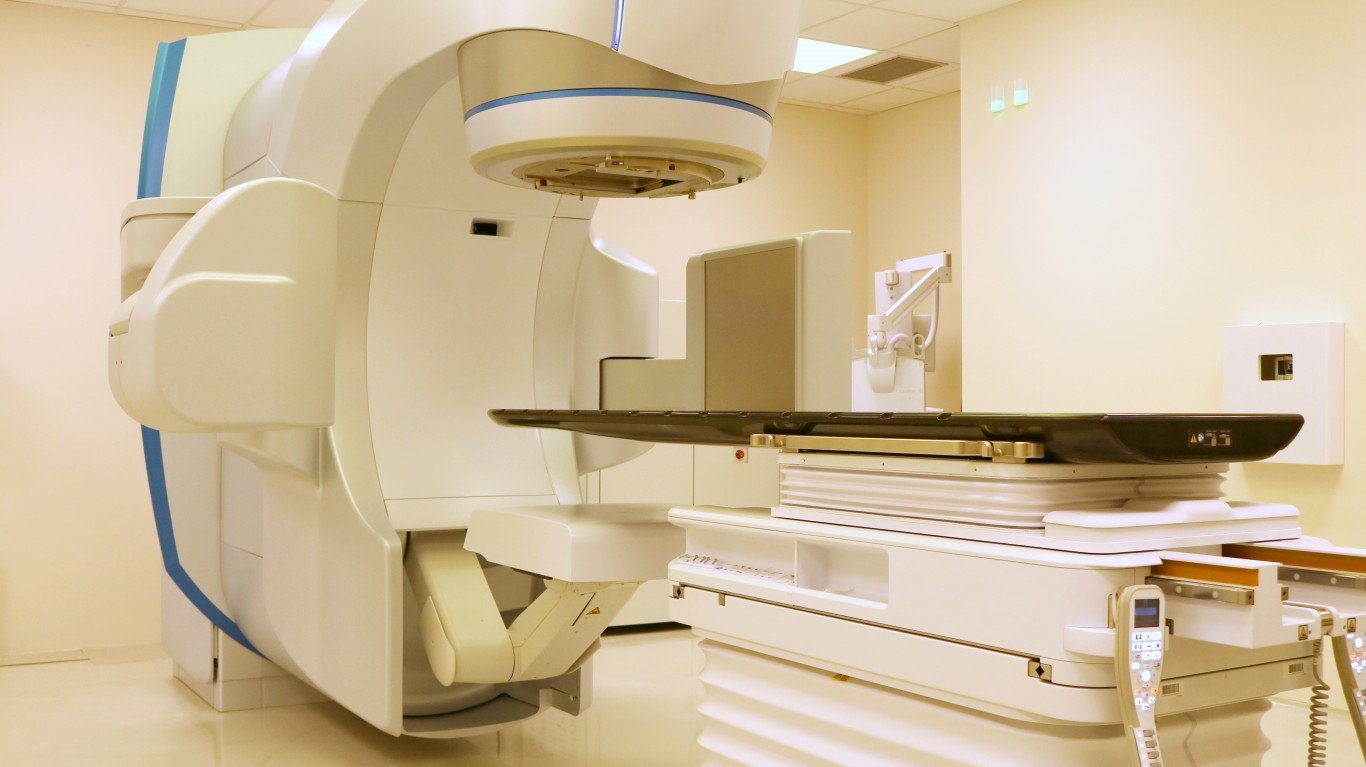
7. New Hampshire
> Cancer diagnoses in 2017 per 100,000 people: 474 (44 more than U.S. avg. of 430 per 100,000 people)
> Total number of cancer diagnoses in 2017: 8,529
> Cancer deaths: 2,760 or 153 per 100,000 people — 23rd lowest
> Female breast cancer incidence: 1,229 or 136 per 100,000 women — 8th highest
> Prostate cancer incidence: 1,100 or 114 per 100,000 men — 20th highest
> Lung cancer incidence: 1,137 or 61 per 100,000 people — 19th highest
> Adult smoking rate: 15.7% — 17th lowest
> Adult obesity rate: 27.9% — 17th lowest
> Residents without health insurance: 6.3% — 13th lowest
[in-text-ad-2]

6. Iowa
> Cancer diagnoses in 2017 per 100,000 people: 477 (47 more than U.S. avg. of 430 per 100,000 people)
> Total number of cancer diagnoses in 2017: 18,600
> Cancer deaths: 6,449 or 158 per 100,000 people — 19th highest
> Female breast cancer incidence: 2,674 or 137 per 100,000 women — 6th highest
> Prostate cancer incidence: 2,324 or 116 per 100,000 men — 19th highest
> Lung cancer incidence: 2,557 or 63 per 100,000 people — 12th highest
> Adult smoking rate: 17.1% — 25th lowest
> Adult obesity rate: 33.2% — 9th highest
> Residents without health insurance: 5.0% — 6th lowest
5. Louisiana
> Cancer diagnoses in 2017 per 100,000 people: 479 (49 more than U.S. avg. of 430 per 100,000 people)
> Total number of cancer diagnoses in 2017: 26,125
> Cancer deaths: 9,512 or 175 per 100,000 people — 5th highest
> Female breast cancer incidence: 3,633 or 129 per 100,000 women — 25th highest
> Prostate cancer incidence: 3,675 or 135 per 100,000 men — 2nd highest
> Lung cancer incidence: 3,564 or 63 per 100,000 people — 10th highest
> Adult smoking rate: 23.1% — 3rd highest
> Adult obesity rate: 35.4% — 4th highest
> Residents without health insurance: 8.9% — 21st highest
[in-text-ad]
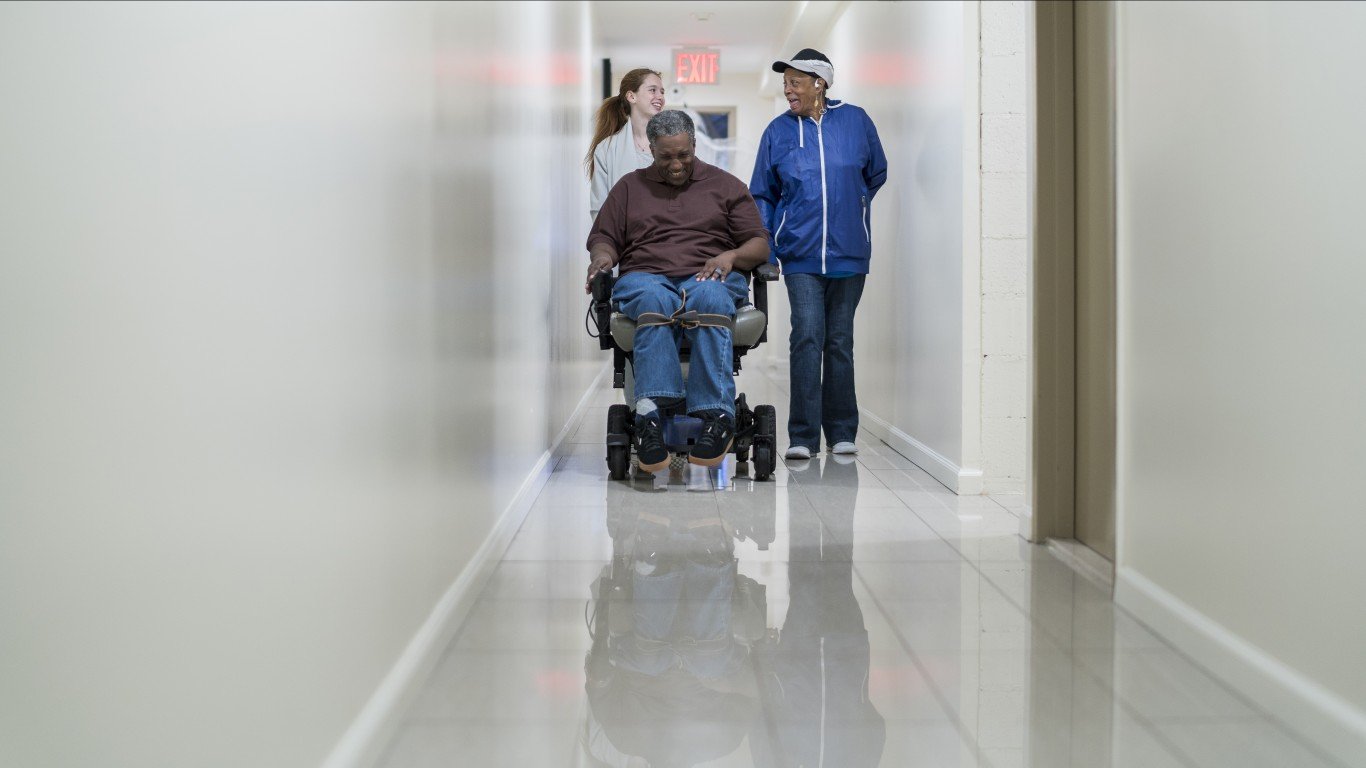
4. New York
> Cancer diagnoses in 2017 per 100,000 people: 481 (51 more than U.S. avg. of 430 per 100,000 people)
> Total number of cancer diagnoses in 2017: 115,007
> Cancer deaths: 34,956 or 142 per 100,000 people — 10th lowest
> Female breast cancer incidence: 16,668 or 135 per 100,000 women — 11th highest
> Prostate cancer incidence: 14,996 or 128 per 100,000 men — 8th highest
> Lung cancer incidence: 14,364 or 58 per 100,000 people — 25th highest
> Adult smoking rate: 14.1% — 9th lowest
> Adult obesity rate: 25.5% — 5th lowest
> Residents without health insurance: 5.2% — 7th lowest

2. New Jersey
> Cancer diagnoses in 2017 per 100,000 people: 482 (53 more than U.S. avg. of 430 per 100,000 people)
> Total number of cancer diagnoses in 2017: 52,841
> Cancer deaths: 16,264 or 146 per 100,000 people — 13th lowest
> Female breast cancer incidence: 7,893 or 138 per 100,000 women — 2nd highest
> Prostate cancer incidence: 7,477 or 140 per 100,000 men — the highest
> Lung cancer incidence: 5,743 or 51 per 100,000 people — 15th lowest
> Adult smoking rate: 13.7% — 7th lowest
> Adult obesity rate: 26.4% — 11th lowest
> Residents without health insurance: 7.9% — 24th lowest

2. West Virginia
> Cancer diagnoses in 2017 per 100,000 people: 482 (53 more than U.S. avg. of 430 per 100,000 people)
> Total number of cancer diagnoses in 2017: 12,143
> Cancer deaths: 4,654 or 179 per 100,000 people — 3rd highest
> Female breast cancer incidence: 1,474 or 115 per 100,000 women — 9th lowest
> Prostate cancer incidence: 1,255 or 95 per 100,000 men — 11th lowest
> Lung cancer incidence: 2,176 or 81 per 100,000 people — 2nd highest
> Adult smoking rate: 26.0% — the highest
> Adult obesity rate: 36.7% — 2nd highest
> Residents without health insurance: 6.7% — 18th lowest
[in-text-ad-2]

1. Kentucky
> Cancer diagnoses in 2017 per 100,000 people: 510 (80 more than U.S. avg. of 430 per 100,000 people)
> Total number of cancer diagnoses in 2017: 27,714
> Cancer deaths: 10,145 or 186 per 100,000 people — the highest
> Female breast cancer incidence: 3,551 or 126 per 100,000 women — 23rd lowest
> Prostate cancer incidence: 2,961 or 109 per 100,000 men — 24th lowest
> Lung cancer incidence: 4,933 or 87 per 100,000 people — the highest
> Adult smoking rate: 24.6% — 2nd highest
> Adult obesity rate: 33.8% — 6th highest
> Residents without health insurance: 6.4% — 14th lowest
Methodology
To identify the incidence of cancer in every state, 24/7 Tempo reviewed the age-adjusted cancer incidence rate in every state using data compiled by the Centers for Disease Control and Prevention. The rate represents the number of new cancer diagnoses per 100,000 people during 2017, the latest year for which data is available, in all 50 states.
The data comes from the report, “United States Cancer Statistics: 2001-2017 Incidence and Mortality Web-based Report,” accessed from the National Program of Cancer Registries and Surveillance, Epidemiology, and End Results Stat Database: U.S. Cancer Statistics 2001–2017, released June 2020.
The percentage of adults who currently smoke as well as the adult obesity rate in each state were obtained from the 2020 County Health Rankings & Roadmaps program, produced by the Robert Wood Johnson Foundation and the University of Wisconsin Population Health Institute. The percentage of residents in every state without health insurance came from the Census Bureau’s American Community Survey 2019 1-Year Estimates.
Take This Retirement Quiz To Get Matched With A Financial Advisor (Sponsored)
Take the quiz below to get matched with a financial advisor today.
Each advisor has been vetted by SmartAsset and is held to a fiduciary standard to act in your best interests.
Here’s how it works:
1. Answer SmartAsset advisor match quiz
2. Review your pre-screened matches at your leisure. Check out the
advisors’ profiles.
3. Speak with advisors at no cost to you. Have an introductory call on the phone or introduction in person and choose whom to work with in the future
Take the retirement quiz right here.
Thank you for reading! Have some feedback for us?
Contact the 24/7 Wall St. editorial team.
 24/7 Wall St.
24/7 Wall St. 24/7 Wall St.
24/7 Wall St.
 24/7 Wall St.
24/7 Wall St.

 24/7 Wall St.
24/7 Wall St.


